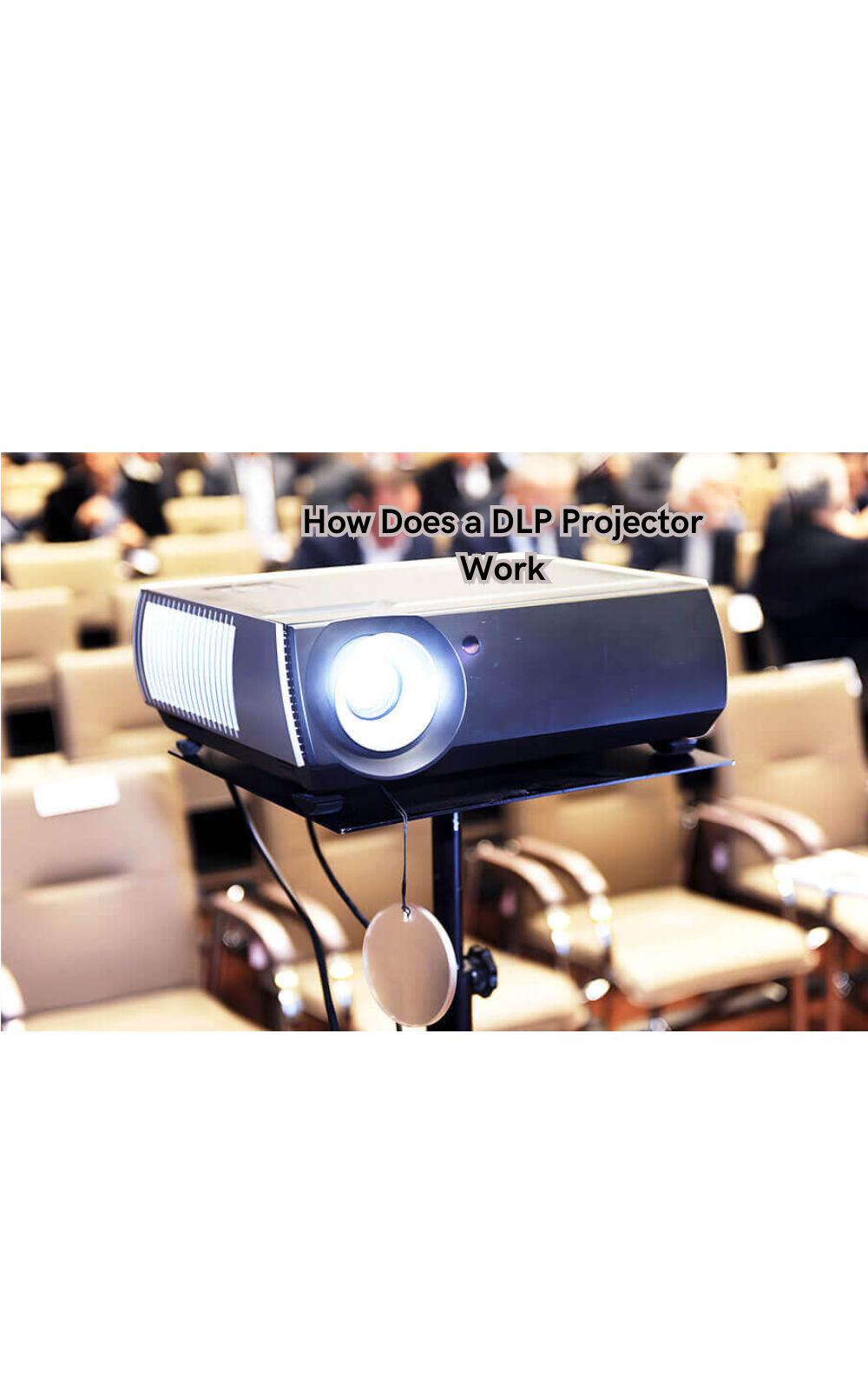How Does a DLP Projector Work
This article delves into the inner workings of DLP projectors, exploring how they deliver stunning visuals in diverse applications.

Digital Light Processing (DLP) projectors revolutionize the way we view images and videos by utilizing advanced micro-mirror technology. Developed by Texas Instruments, DLP technology relies on a chip containing tiny mirrors to reflect light and create sharp, vibrant visuals.
This innovation is significant due to its high image quality, fast response times, and reliability, making DLP projectors a popular choice in various fields.
From immersive home theater experiences to dynamic business presentations, and educational tools to large-scale event displays, DLP projectors offer versatile and efficient solutions for visual projection needs.
This article delves into the inner workings of DLP projectors, exploring how they deliver stunning visuals in diverse applications.
What is DLP Technology?
DLP technology is a type of projection display that uses a digital micro-mirror device (DMD) to reflect light onto a screen or surface.
The DMD contains millions of tiny mirrors that are individually controlled by electrical signals, allowing for precise manipulation and reflection of light. This creates the image displayed on the screen, with each mirror representing one pixel of the image.
Unlike traditional LCD projectors that use polarized light, DLP projectors use a reflective process, resulting in higher contrast levels and better color accuracy.
Additionally, DLP projectors have faster response times as they do not require color filters or liquid crystal panels to create images. This enables them to project smoother motion and eliminate the "rainbow effect" commonly seen in other projectors.
Key Components of a DLP Projector
A DLP projector consists of several key components that work together to create a seamless and high-quality visual experience. These include:
- Light Source: This is the primary source of light used to project images, typically a powerful lamp or LED.
- Color Wheel: The color wheel is a rotating disc containing red, green, and blue filters that filter the white light from the lamp into separate colors. This allows for accurate color representation in the projected image.
- Digital Micro-Mirror Device (DMD): This chip contains millions of tiny mirrors that reflect light onto the screen. Each mirror represents one pixel of the image.
- Projection Lens: The projection lens focuses and directs the reflected light onto the screen, creating a clear and sharp image.
- Processing and Control Circuitry: This is the brain of the projector, responsible for receiving and processing input signals, controlling the DMD and color wheel, and adjusting various settings such as brightness and contrast.
- Cooling System: As projectors produce a significant amount of heat, they require a cooling system to prevent overheating and ensure optimal performance.
In modern DLP projectors, some of these components are replaced with newer technologies such as laser light sources and solid-state LED light engines. These advancements offer longer lifespan, better energy efficiency, and improved color accuracy.
Applications of DLP Projectors
DLP projectors are used in various applications due to their versatility, high image quality, and reliability. Some common uses include:
- Home Theater Systems: With their ability to deliver stunning visuals with accurate colors and no "motion blur," DLP projectors are popular among home theater enthusiasts.
- Business Presentations: DLP projectors are widely used in business settings for their fast response times, high contrast levels, and portability. They are ideal for presenting data, charts, and graphics with great clarity.
- Education: Many educational institutions use DLP projectors as teaching aids due to their ability to display high-quality images and videos. They are also commonly used in interactive classrooms with features such as touch screen control.
- Large-Scale Events: Due to their bright, vibrant colors and large projection capabilities, DLP projectors are often used at concerts, sporting events, and other large-scale gatherings to display live footage or advertisements on big screens.
Applications for DLP projectors are constantly expanding as technology advancements allow for smaller, more portable devices with higher image quality. Whether it's in the comfort of your home or at a large event, DLP projectors continue to transform the way we view and interact with visual content.
How Does a DLP Projector Work?
To understand how a DLP projector works, we must first look at the process of projection. The basic principle is to project light through an image and onto a surface, creating a larger or magnified version of that image. In the case of DLP projectors, this process is achieved using micro-mirror technology.
The first step is the light source. The brightness and clarity of the projected image depend on the quality and strength of the light source. This can be in the form of a powerful lamp or LED.
Next comes the color wheel. As mentioned earlier, this rotating disc contains red, green, and blue filters that filter white light into separate colors. This allows for accurate color representation in the projected image. The color wheel spins rapidly, and the DMD chip controls how much light is reflected from each mirror onto the screen.
Now, let's take a closer look at the DMD chip. This tiny chip contains millions of microscopic mirrors that correspond to each pixel in the projected image. These mirrors are controlled by electrical signals sent from the processing and control circuitry, which receives input signals from a connected device such as a laptop or DVD player. By manipulating these mirrors individually, the DMP chip can create an accurate representation of the original image on the surface it is projecting onto.
After reflecting off of the DMD, light passes through a projection lens, which focuses and directs the light onto the screen or surface. The projection lens can be manually adjusted to achieve the desired image size and clarity.
Advantages of DLP Projectors
DLP projectors offer numerous advantages over other types of projectors, making them a preferred choice in various applications. Some key benefits include:
- High Contrast Levels: Due to their reflective process, DLP projectors can produce significantly higher contrast levels than LCD and other projector technologies. This results in sharper and more defined images with better color accuracy.
- No Motion Blur or "Rainbow Effect": With their fast response times and lack of moving parts, DLP projectors can display smooth motion without any blur or image distortion. They also eliminate the "rainbow effect" commonly seen in some other projector technologies.
- Longer Lifespan: As DLP projectors use a single light source and do not have any filters to replace, they generally have a longer lifespan than other types of projectors. This makes them more cost-effective in the long run.
- Compact Design: DLP projectors are typically smaller and more lightweight than other projector technologies, making them easier to transport and set up in various locations.
- Low Maintenance: With fewer moving parts and no filters to clean or replace, DLP projectors require minimal maintenance, saving time and effort for users.
These advantages make DLP projectors a popular choice in various settings, from home theaters to large-scale events. As technology continues to advance, DLP projectors are becoming even more versatile and efficient, making them an essential tool for delivering high-quality projected images.
Comparison with Other Projection Technologies
While DLP projectors offer many advantages, they are not without competition. Other types of projection technologies include LCD (liquid crystal display) and LCoS (liquid crystal on silicon) projectors. Each has its own unique features and benefits.
LCD projectors use three liquid crystal displays to create images by filtering light through red, green, and blue panels. They are known for their high brightness levels and color accuracy but can suffer from motion blur and the "screen door effect," where the image appears pixelated.
LCoS projectors use a reflective surface with liquid crystals to create images, similar to DLP technology. However, they typically have higher native resolutions than DLP projectors but can also suffer from "screen door effect" and are often more expensive.
In comparison, DLP projectors offer a balance of high brightness levels, excellent contrast, and color accuracy with minimal drawbacks. They also tend to be more cost-effective than LCoS projectors.
How to Maintain DLP Projectors
To ensure optimal performance and longevity, DLP projectors require proper maintenance. Some key tips for maintaining a DLP projector include:
- Cleaning the Lens: Regularly wiping the lens with a soft, microfiber cloth will help remove any dust or smudges that may affect image quality.
- Replacing the Lamp: As the main source of light in a DLP projector, the lamp should be replaced according to manufacturer recommendations or when it begins to lose brightness.
- Cleaning Filters (if applicable): Some DLP projectors may have filters that need to be cleaned or replaced periodically. These filters help prevent dust and debris from entering the projector's internal components.
- Proper Storage: When not in use, DLP projectors should be stored in a clean and dry environment to prevent dust from accumulating inside.
- Regular Maintenance Check-ups: It is also recommended to have a professional technician perform regular maintenance check-ups on the projector to ensure all components are functioning correctly.
By following these maintenance tips, users can prolong the life of their DLP projectors and continue to enjoy high-quality projected images for years to come.
FAQs
How does a single chip DLP projector create an image?
A single chip DLP projector works by using a digital micromirror device (DMD), which consists of thousands of tiny mirrors. Each mirror corresponds to a pixel on the projection screen. The DLP chip directs light towards these mirrors, which tilt to either reflect light through the lens to create an image or away to keep the area dark.
What is the role of the DLP chip in DLP projectors?
The DLP chip in DLP projectors plays a crucial role in image production. It manages the reflection of light beams onto the projection screen, using the digital micromirror device (DMD). This technology allows for precise control over each pixel displayed, resulting in sharp images with high color accuracy.
How do laser DLP projectors differ from traditional lamp-based projectors?
Laser DLP projectors use laser lights as the light source instead of traditional lamps. This change offers several advantages, including longer lifespan, lower maintenance, and a broader color gamut. Laser DLP projectors beam light more efficiently, providing brighter images and better color accuracy, especially notable in DLP cinema projection systems.
What benefits do single chip DLP projectors offer in terms of light management?
Single chip DLP projectors offer significant benefits in terms of light management by minimizing the loss of light. Since they use a single DLP chip and digital micromirror device (DMD), these projectors can more efficiently direct blue light and other colors to the projection screen, enhancing the brightness and clarity of the image.
Conclusion
In conclusion, DLP projectors leverage Digital Light Processing technology to deliver high-quality, sharp, and vibrant visuals through advanced micro-mirror mechanisms.
Key components like the DMD chip, light source, and color wheel work in harmony to project clear images. DLP projectors stand out due to their fast response times, reliability, and compact design, making them ideal for various applications.
Whether enhancing home theaters, facilitating business presentations, supporting educational activities, or powering large-scale events, DLP projectors offer versatile and effective solutions. As DLP technology continues to evolve, it promises even more innovative and impactful advancements in the world of visual projection.
